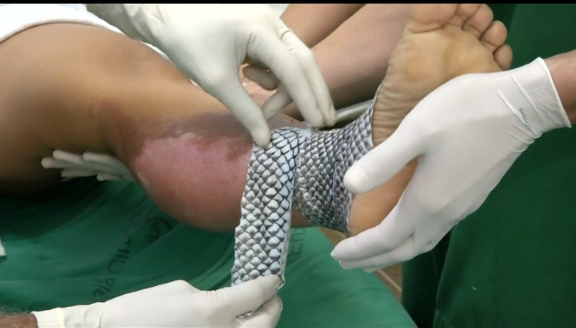EXPLORING MEDICAL MIRACLES OF TILAPIA SKIN: FROM BURNING TO NEW SKIN
According to the world health organization, Injury by burning is a universal health problem and it’s an immense curse for the people of middle & low-income countries. Usually, the skin is injured by burn through different mode acting as high heat, radiation, electricity, radioactivity, friction or contact with burning chemicals. The skin of Tilapia help to heal the burn more quickly than any other skin grafting treatment process.
Tilapia is a fish that can be cultivated anywhere on the planet. Generally,Tilapia is a prolific breeder & it can survive in low oxygenated water even polite water also. In India, Tilapia farming is very popular for its adaptation quality & low-cost management. Tilapia fish is enriched with protein, vitamins, and minerals such as vitamin B12, vitamin D, niacin, choline, selenium, phosphorous, calcium, magnesium, etc. Scientists are reported that Tilapia fish is a superior source of Omega 3 fatty acids. Tilapia skin contains a vast amount of moisture & Type 1 collagen protein that is used to treat secondary burn treatment.
Skin grafting is commonly applied on a burn patient when doctors extract a thin layer of skin from the healthier part of the patient skin and place it on the top of the burn site. After a couple of days, the grafted skin will start to form a new skin over the injured skin. In the skin grafting method, a genetically modified pig’s skin is utilized for performing the whole task. Application of Tilapia skin proves double time more viable and effective for pain management & reduced healing time than utilizing pig’s skin, human donor or silicone gel to a treat the burn patient. Collagen content of Tilapia skin also act as an influencer to growepidermal & fibroblast growth factor expression which can initiate the proliferation of fibroblast & keratinocytes.
Tilapia fish skin has garnered attention for its innovative and effective use in medical treatments, particularly for skin rejuvenation and burn therapy. This novel approach leverages the unique properties of tilapia skin to promote healing and improve skin health. Here's an in-depth look at why tilapia fish skin is becoming a popular choice in medical treatments:
Collagen Content
Tilapia fish skin is rich in type I collagen, a protein essential for skin repair and regeneration. Collagen is a major component of the skin's extracellular matrix, providing structure and support. When applied to wounds, the collagen from tilapia skin helps to enhance the skin’s natural healing processes. It stimulates the proliferation of fibroblasts, which are critical cells involved in wound healing and tissue repair. This leads to faster and more effective skin regeneration.
Antimicrobial Properties
One of the significant advantages of tilapia skin is its inherent antimicrobial properties. The skin contains natural antimicrobial peptides that help to reduce the risk of infection in wounds. This is particularly important in burn treatment, where the risk of bacterial infection is high. By preventing infections, tilapia skin promotes a safer healing environment, which is crucial for patients with severe burns or other open wounds.
Moisture Retention
Maintaining a moist environment is critical for optimal wound healing. Tilapia skin excels in moisture retention, which helps keep the wound hydrated. This not only accelerates the healing process but also reduces pain and discomfort for the patient. Traditional bandages and dressings can often dry out the wound, leading to increased pain and slower healing. In contrast, tilapia skin creates a moist, protective barrier that supports faster recovery
Cost-Effectiveness
In many parts of the world, access to advanced medical treatments and materials can be limited due to cost constraints. Tilapia skin offers a cost-effective alternative to traditional biological dressings. It is relatively inexpensive to produce and more readily available, especially in regions where tilapia is farmed extensively. This makes it a practical and accessible option for many healthcare providers and patients.
Ease of Use
The practical application of tilapia skin in medical settings is straightforward. The skin can be sterilized, processed, and stored for future use. When applied to a wound, it adheres well, forming a protective barrier that stays in place until the skin underneath has healed sufficiently. This ease of use is particularly beneficial in emergency situations where quick and efficient treatment is necessary.
Biocompatibility
Tilapia skin is highly biocompatible with human skin, meaning it does not typically cause adverse reactions. This is crucial for ensuring that the treatment is safe and effective. Biocompatibility reduces the risk of rejection and other complications that can arise from using foreign materials on the body. Patients generally tolerate tilapia skin well, making it a reliable option for various skin injuries.
Clinical Success
The use of tilapia fish skin in medical treatments has shown promising results in clinical settings. In Brazil, for example, this method has been adopted in several hospitals with significant success. Patients treated with tilapia skin have experienced faster healing times, reduced pain, and better overall outcomes compared to traditional treatments. The innovative approach is gaining recognition and is being considered for broader use in other parts of the world.
Conclusion
Tilapia fish skin represents a groundbreaking advancement in wound care and skin rejuvenation. Its high collagen content, antimicrobial properties, ability to retain moisture, cost-effectiveness, ease of use, and biocompatibility make it an excellent choice for treating burns and other skin injuries. As research and clinical trials continue to support its efficacy, tilapia skin is poised to become a standard treatment option, offering hope and improved quality of care for patients worldwide.




Comments
Post a Comment